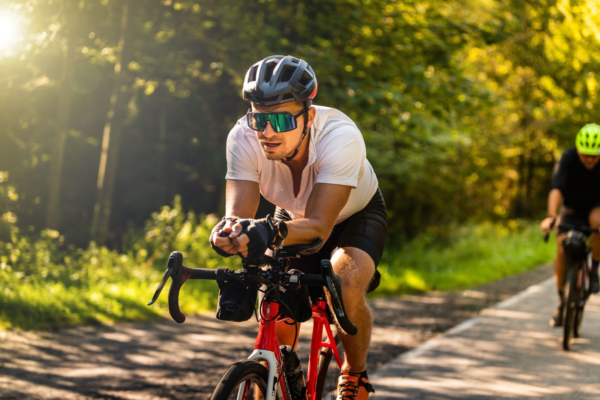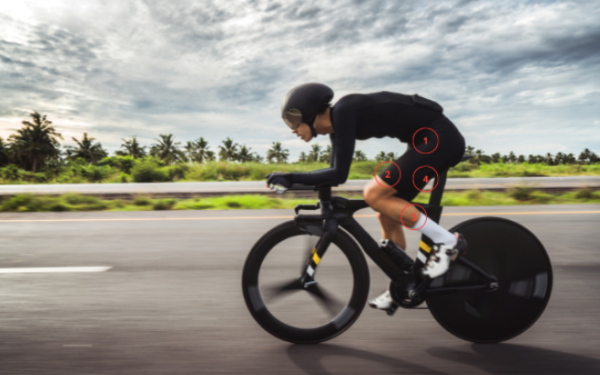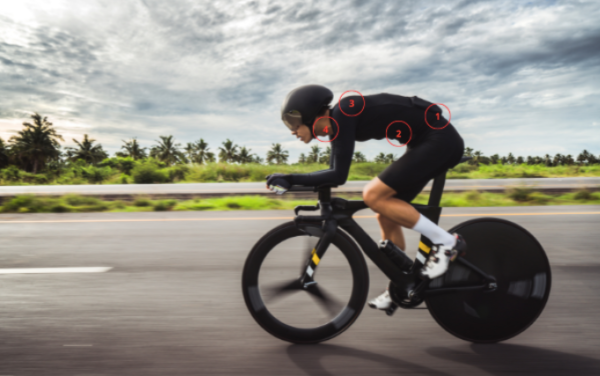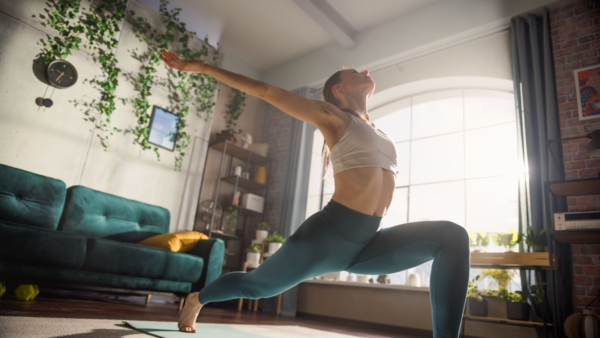How to Fix Muscle Imbalances From Cycling
Oct 31, 2023
While cycling is a phenomenal activity for cardiovascular strength, lower body endurance, and social-mental well-being, it has some drawbacks. One of them is its ability to overwork certain muscles and neglect others because of the static positions we hold while riding. This makes learning how to fix muscle imbalances a valuable tool that every cyclist should learn.

(Image credit: Adobe Stock)
What Is a Muscle Imbalance?
A muscle imbalance refers to an uneven distribution of strength, flexibility, or development between opposing or synergistic muscles or muscle groups. It occurs when certain muscles are stronger, tighter, or more dominant compared to their antagonist or complementary muscles. This imbalance can lead to altered movement patterns, poor posture, and increased risk of injury.
Muscle imbalances can occur due to repetitive movements (like pedaling), poor exercise technique (resultant of an improper bike fit, for example), sedentary lifestyles, or training practices that focus on certain muscle groups while neglecting others. Identifying and addressing muscle imbalances is essential for maintaining optimal health and balance in the body.
As cyclists, we are incredibly prone to developing muscle imbalances for several reasons. Some of these include:
- We sit on the bike and stay in more or less the same positions throughout the duration of our rides.
- Those positions compromise certain parts of our bodies and overstretch or overtighten them (for example, overstretching of the lower back).
- Your joints are only being moved in limited ranges of motion.
- Pedaling emphasizes the use of certain muscles (for example, quads) to the neglect of others (glutes and entire upper body).
While this may all sound discouraging, there is a silver lining. The lack of movement and limited positioning in our sport allows us to easily identify common muscle imbalances likely to occur. We can consequently address them in a systematic manner. This usually involves stretching muscles that are strong and tight, and strengthening muscles that are long and weak.
Lower Body Muscle Imbalances From Cycling
Cycling is predominantly a lower body sport. Let’s take a look at some of the common muscle imbalances that can occur because of the positioning of our bodies on the bike. Use the picture below for reference.

Use this picture for reference when reading the information below. (Image credit: Adobe Stock)
1. Hip Flexor Tightness
The hips never fully extend when you’re riding on the bike, so they’re always in a semi-flexed position. This wreaks havoc on a group of muscles called your hip flexors, which have a function of driving the knee up towards the chest, among other things. One of them attaches to your lumbar spine, so when they get tight, they pull on the low back and cause it to excessively arch.
How to Fix: If you feel an ache in the low back and/or hip area, stretching the hip flexors might provide significant relief. Couple this with strengthening the muscles on the other side of the hip, which would be your glutes. This can be done through exercises that require you to forcefully extend the hips, like deadlifts and squats.
2. Quadricep Dominance
The quadriceps get hammered in cycling, and their overuse can lead to problems such as cyclist’s knee, otherwise known as patellofemoral pain syndrome. Their constant recruitment is to the neglect of muscles on the other side of the thigh, like your hamstrings and gluteal muscles. All of this equates to tight quads, possible knee pain, weak hip extensors and weak knee flexors.
How to Fix: Stretching the quadriceps during your off time is a great place to start, foam rolling them may be beneficial as well, especially on the quad tendon (just above the kneecap). Also, perform exercises that strengthen the hamstrings and glutes, such as good mornings, hip thrusts, lunges, and banded hamstring curls.
3. Calf/Ankle Tightness
The structures in your lower leg, like your calf muscles (gastrocnemius, soleus) and achilles tendon perform substantial work at the bottom of your downstroke, especially in the standing position while going uphill. Tight, inflexible cycling shoes can also limit range of motion in the foot, and contribute to stiffness in the lower leg.
How to Fix: Doing separate stretches for the gastrocnemius and soleus will help relieve tension in the lower leg and provide relief further down in the achilles tendon. Foam rolling these areas can also help. You can also work on strengthening the front of the lower leg by doing exercises that lift the toes up towards the shin. Be sure to wear cycling shoes that fit your needs, as well.
4. Hamstring Tightness/Weakness
The hamstrings do most of the hip extension in cycling thanks to a phenomenon called synergistic dominance. The glutes would normally take this responsibility, but because of the mechanically disadvantaged position the bike puts your glute muscles in, the hamstrings take over and try to do the work of both muscles. Resulting in tightness and exhaustion.
How to Fix: Start by regaining mobility and flexibility in the hamstrings. From there, you have to be sure to train the hamstrings and glutes adequately in your strength training sessions. They are getting a warped stimulus on the bike, so it’s up to you to balance out the system with exercises that stimulate both properly, like deadlifts, hip thrusts, squats, and lunges.
Upper Body Muscle Imbalances From Cycling
While the upper body remains mostly stationary, it is still subject to uneven loads based on the positions we have to hold. Here are some common upper body problems that develop as a result of cycling. Use the below picture for reference.

Use this picture for reference when reading the information below. (Image credit: Adobe Stock)
1. Low Back Weakness & Pain
Over half of cyclists report having lower back pain. If we look at the cyclist above, his lower back is sitting in a stretched, rounded position. Cycling also doesn’t strengthen the low back in any way. These two things are why so many cyclists get lower back spasms, as the muscles forcefully contract to try to pull the person back into a normal position.
How to Fix: Because the backs of many cyclists feel tight, they think it needs to be stretched - this is wrong. It is being overstretched on the bike, and is resultantly weak. It feels tight because it is contracting to try and support itself. We need to strengthen it through exercises such as back extensions, prone holds, deadlifts, and kettlebell swings.
2. Core Weakness & Instability
There are many abdominal muscles, all with different functions. The rectus abdominis (your “six pack”) alone has 8-12+ nerve innervations, which means it can do a lot of things at once. Cycling is linear, and only takes place in the sagittal plane. To properly stimulate the core, we need to challenge it with varied movement to keep it strong, healthy, and supportive.
How to Fix: We need to challenge our core and integrate it with the rest of our body through full-body strength movements. Bodyweight exercises like pushups and pullups, and also external resistance exercises such as overhead press, squats, rows, etc. We also need to twist our torso through movements like woodchops and pallof presses.
3. Upper Back Rounding (Kyphosis)
Similar to the low back, our upper backs get overstretched while cycling. This forces the muscles in the upper back to constantly relax and weaken. Modern lifestyles also put us into this rounded back, head forward position. It produces an ugly posture that has implications all throughout the body, and is the source of many peoples back and neck pain.
How to Fix: We need to work on strengthening the upper back into extension in our strength training programs. Three of the best exercises to help do this are front squats, prone cobra holds, and deadlifts. All of these focus on thoracic (upper back) extension. By strengthening good posture off the bike, it will better allow us to go into cycling specific postures while riding.
4. Tight Chest, Shoulders & Poor Breathing
A tag-along partner of upper back rounding and overstretching is the overtightening of muscles on the other side of the body, namely the chest and front of the shoulders. Coupled with forward head posture, all of these things contribute to shallow chest breathing and a resultant reduced lung capacity, overworked neck, and other symptoms like chronic headaches.
How to Fix: Focus on stretching the chest and front of the shoulder. Pair this with strengthening the back of the shoulder as well as the mid-upper back. You’ll want to also do other exercises like a wall-lean to strengthen the back of the neck to pull your head back into alignment. Try to always breathe into the belly (with your diaphragm) during the day to optimize oxygen intake.

(Image credit: Adobe Stock)
Fix Muscle Imbalance With Dynamic Cyclist!
Our extensive programming at Dynamic Cyclist has exercises built-in to help prevent the unique challenges cyclists have to deal with. We’re cyclists ourselves and know how frustrating it is to have to spend time away from the bike. Try us out for 7-days free by clicking here, and learn how it feels to ride pain-free!
Written by Eric Lister – Certified Personal Trainer & Corrective Exercise Specialist





